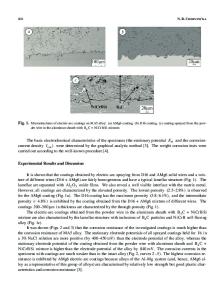Electrochemical characteristics of electric-arc aluminum coatings on AZ31 magnesium alloy
- PDF / 594,403 Bytes
- 4 Pages / 595.276 x 793.701 pts Page_size
- 0 Downloads / 314 Views
ELECTROCHEMICAL CHARACTERISTICS OF ELECTRIC-ARC ALUMINUM COATINGS ON AZ31 MAGNESIUM ALLOY N. R. Chervins’ka The possibilities of improvement of the corrosion resistance of AZ31 magnesium alloy by spraying AlSi5 electric-arc coatings with their subsequent melting by an Nd : YAG laser of quasicontinuous action are analyzed. The electrochemical characteristics of the surface layers in aqueous media are studied. It is shown that the AlSi5 electric-arc coatings significantly increase the corrosion resistance of the magnesium alloy.
Due to their low density and high strength, magnesium alloys prove to be promising structural materials for various branches of machine building and instrument making [1, 2]. However, as their principal disadvantages, we can mention insufficient corrosion resistance, low hardness, and wear resistance in the processes of abrasive and dry friction. This problem can be solved by applying gas-thermal and other coatings to the surfaces. In [3], it is shown that numerous operating characteristics can be improved as a result of the deposition of gas-flame aluminum coatings on the surfaces of magnesium alloys and their subsequent laser melting. However, this procedure is less efficient than electric-arc spraying. Despite its high efficiency, the procedure of electric-arc spraying gives highly porous coatings whose corrosion resistance is now insufficiently well studied. This is why, in the present work, we study the influence of aluminum coatings deposited on AZ31 magnesium alloy by electricarc spraying and the surface layers formed as a result of subsequent laser melting of these coatings on their electrochemical characteristics. Materials and Procedure We studied AZ31 magnesium alloy (0.2% Mn, 3.1% Al, 1.3% Zn, 0.1% Cu, 0.08% Si, balance Mg). The specimens were 30 × 20 × 8 mm in size with coatings obtained by electric-arc spraying from AlSi5 alloy (Al + 5% Si). The thickness of the coatings was ∼250 μm. Prior to spraying, the surfaces of the specimens were subjected to shot blasting up to the surface roughness Rz = 40 – 45 in order to guarantee the required adhesive forces between the coating and the base. To reduce the structural and chemical heterogeneity and porosity and increase the forces of adhesion to the base, some coatings were melted by the radiation of a Nd: YAG laser applied in the modes described in [4]. The microstructure of the modified layers was studied with the help of a LEO 1455VP electron microscope. The wear resistance was analyzed according to a nonstandard procedure by using an abrasive wheel made of SM-2 synthetic medium-hardness corundum with 7K15 ceramic binder [1]. In the course of electrochemical investigations, the potentiodynamic curves were recorded in an IRC-Pro potentiostat for a standard three-electrode cell. A saturated silver-chloride electrode played the role of the reference electrode and a platinum electrode was used as the auxiliary electrode. The potential sweep rate was equal to 1 mV / sec and the temperature of the corrosive medium (distilled water) was ∼
Data Loading...











